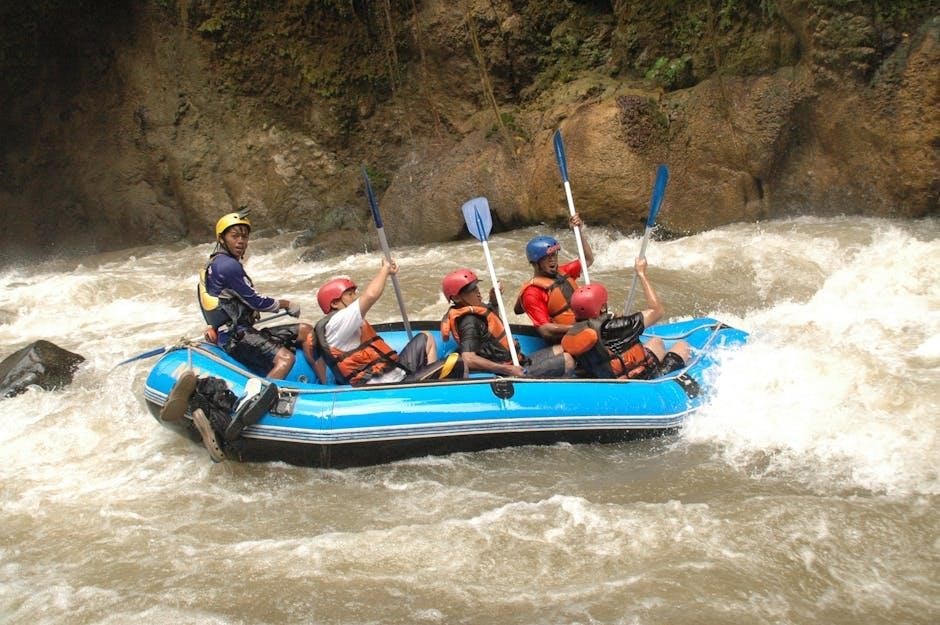Overview of Atwood RV Water Heaters
Atwood RV water heaters provide reliable hot water solutions for RVers, combining convenience and efficiency. Regular maintenance ensures optimal performance and prevents common issues from arising.
Atwood RV water heaters are popular for their reliability and efficiency, offering both gas and electric models. Designed for RVers, they provide consistent hot water on the go. Known for durability, these heaters require regular maintenance to ensure optimal performance. Troubleshooting guides help address common issues, ensuring uninterrupted access to hot water during travels.
1.2 Importance of Regular Maintenance
Regular maintenance is crucial for extending the lifespan of Atwood RV water heaters and ensuring reliable performance. It helps prevent common issues like leaks, faulty thermostats, and gas supply problems. Proper upkeep also enhances safety, especially with gas models, and maintains energy efficiency. Neglecting maintenance can lead to unexpected breakdowns and costly repairs, disrupting your RV adventures.
Common Issues with Atwood RV Water Heaters
Common issues include pilot light problems, gas supply disruptions, electrical faults, thermostat malfunctions, and water leaks, often requiring timely troubleshooting to ensure proper function.
2.1 Pilot Light Problems
Pilot light issues are common in Atwood RV water heaters, often caused by drafts, dirt, or faulty thermocouples. If the pilot light won’t stay lit, check for obstructions in the pilot tube, ensure proper gas flow, and verify the thermocouple’s functionality. Cleaning the pilot orifice and ensuring adequate ventilation can often resolve these issues effectively.
2.2 Gas Supply and Pressure Issues
Gas supply and pressure issues can disrupt Atwood RV water heater operation. Low propane levels, faulty regulators, or clogged gas lines often cause these problems. Ensure the propane tank is sufficiently filled and check for blockages in the gas lines. Verify that the regulator is set correctly and functioning properly to maintain the required pressure for optimal performance.
2.3 Electrical Connection Faults
Electrical issues often stem from loose or corroded connections. Check the circuit breakers and fuses to ensure they are functioning properly. Verify that all wiring is secure and undamaged. Faulty thermostats or malfunctioning heating elements can also cause electrical problems. Regularly inspect connections and components to prevent disruptions in your Atwood RV water heater’s operation and ensure safe, efficient performance.

Troubleshooting Electrical Problems
Troubleshooting electrical issues involves identifying faulty components like fuses, circuit breakers, or wiring. Always disconnect power before inspecting or repairing to ensure safety and prevent further damage.
3.1 Checking Fuses and Circuit Breakers
Start by inspecting the RV’s electrical panel to locate the water heater circuit. Check for blown fuses or tripped breakers. Replace fuses or reset breakers if necessary. Ensure all connections are secure and free from corrosion. If issues persist, consult the wiring diagram or contact a certified technician to avoid further electrical complications and ensure safe operation.
3.2 Inspecting Wiring and Connections
Visually inspect the wiring and connections for signs of damage, corrosion, or looseness. Use a multimeter to test for continuity and voltage drops. Ensure all connectors are securely attached and free from rust. Replace any damaged wires or connectors to restore proper electrical flow. If unsure, consult the service manual or contact a certified technician to avoid further complications and ensure safe operation.

Gas System Troubleshooting
Gas system troubleshooting involves verifying propane supply, checking connections, and ensuring proper pressure. Cleaning the pilot tube and orifice can resolve ignition and flow issues, ensuring reliable operation.
4.1 Verifying Propane Supply
Verifying propane supply involves checking the propane tank level and ensuring the valve is fully open. Inspect connections for leaks and ensure the regulator operates within the correct pressure range. A malfunctioning regulator or empty tank can disrupt the gas flow, preventing the water heater from igniting or maintaining a flame.
4.2 Cleaning the Pilot Tube and Orifice
Cleaning the pilot tube and orifice is essential to ensure proper gas flow and ignition. Use compressed air or a small brush to remove debris and soot buildup. Turn off the propane supply before starting and ensure the area is well-ventilated. A clean pilot tube ensures consistent ignition, preventing issues like intermittent operation or failure to light.

Thermostat and Temperature Control Issues
The thermostat regulates water temperature, preventing scalding or cold water. Issues like inconsistent temperatures may indicate a faulty or miscalibrated thermostat, requiring adjustment or replacement.
5.1 Adjusting or Replacing the Thermostat
Adjusting or replacing the thermostat can resolve temperature control issues. Start by checking the thermostat settings and ensure it’s calibrated correctly. If issues persist, replace the thermostat with a compatible model. Always refer to the service manual for specific instructions and safety precautions. This ensures accurate temperature regulation and prevents further complications.
5.2 Checking for Faulty Temperature Sensors
A faulty temperature sensor can cause inconsistent water temperatures. To diagnose, use a multimeter to test for continuity and voltage at the sensor terminals. Ensure the sensor is clean and properly connected. If readings are abnormal, replace the sensor with an OEM-compatible part. Always consult the service manual for specific instructions and safety guidelines to maintain accurate temperature control and system efficiency.

Water Leaks and Plumbing Problems
Water leaks and plumbing issues are common in RV water heaters. Inspect the tank, pipes, and connections for cracks or corrosion. Replace worn seals or gaskets to prevent further damage. Ensure all fittings are tightened securely and check for mineral buildup that may cause leaks. Addressing these problems promptly prevents water damage and maintains system efficiency.
6.1 Identifying Leaks in the Tank or Pipes
Leaks in the tank or pipes are often caused by corrosion, loose connections, or worn-out seals. Inspect the tank for rust spots or water stains. Check pipes for cracks or mineral buildup. Look for puddles near the heater or under the RV. Use a dry cloth to detect moisture on connections. Addressing leaks promptly prevents further damage and ensures reliable water supply.
6.2 Replacing Worn-Out Seals or Gaskets
Worn-out seals or gaskets are common causes of leaks in Atwood RV water heaters. To replace them, turn off the heater and water supply. Inspect the tank and pipes for damaged seals. Remove the old gaskets and clean the area thoroughly. Install new, compatible seals or gaskets, ensuring a tight fit. Apply a silicone-based sealant if needed. Test the system for leaks after replacement to ensure proper function.

Advanced Troubleshooting Techniques
Advanced troubleshooting involves using diagnostic tools to identify complex issues and testing components like circuit boards and relays. Always follow safety protocols to avoid hazards.
7.1 Using Diagnostic Tools for Circuit Boards
Diagnostic tools are essential for identifying issues in Atwood RV water heater circuit boards. These tools can test power circuits, sense circuits, and spark generation. Regularly inspect relays and heating elements for faults. Ensure all connections are secure and free from corrosion. Always disconnect the battery before testing continuity or voltage. This helps prevent electrical shocks and ensures accurate readings. Proper diagnostic techniques are crucial for effective repairs.
7.2 Testing Heating Elements and Relays
Testing heating elements and relays is crucial for diagnosing electrical issues in Atwood RV water heaters. Use a multimeter to check resistance and ensure proper voltage. Inspect elements for mineral buildup or corrosion. Verify relays are functioning correctly by listening for clicks and checking continuity. Replace faulty components to restore heating functionality. Always disconnect power before testing to avoid electrical hazards and ensure accurate results.

When to Call a Professional
Call a professional for complex repairs, such as electrical faults, persistent leaks, or component replacements, ensuring safety and expertise for advanced Atwood RV water heater issues.
8.1 Complex Repairs Beyond DIY
Advanced issues like internal component replacements or electrical system overhauls require professional expertise. These repairs involve specialized tools and knowledge, posing safety risks if attempted without proper training. Always consult a certified technician for such complex tasks to ensure reliability and safety of your Atwood RV water heater system.
8.2 Safety Precautions for Advanced Issues
Always disconnect power and gas supplies before attempting complex repairs. Use a multimeter to ensure no voltage is present. Wear protective gear and avoid open flames near gas components. Never bypass safety devices like thermal cutoffs. If unsure, consult a professional to prevent accidents and ensure compliance with safety standards for your Atwood RV water heater system.

Step-by-Step Solutions from Service Manuals
Service manuals provide detailed step-by-step guides for resetting systems, replacing components, and diagnosing issues. Follow procedures like draining tanks or checking electrical connections to resolve problems efficiently.
9.1 Resetting the Water Heater System
Resetting your Atwood RV water heater system often resolves minor issues. Start by turning off the unit and incoming water supply. Open the nearest hot water faucet to drain the system. After a few minutes, close the faucet and turn the power back on. This process can clear internal blockages and restore functionality effectively.
9.2 Replacing Faulty Components
Identifying and replacing faulty components is crucial for restoring your Atwood RV water heater’s functionality. Common issues include damaged thermostats, heating elements, or electrical connections. Always disconnect power and water supply before starting repairs. Refer to the service manual for specific instructions. Replace worn-out parts with genuine Atwood components to ensure compatibility and safety. After installation, test the system to confirm proper operation.

Preventative Maintenance Tips
Regular inspections and maintenance are key to preventing issues with your Atwood RV water heater. Schedule routine checks to ensure optimal performance and longevity.
10.1 Scheduling Routine Inspections
Scheduling regular inspections for your Atwood RV water heater is essential to identify potential issues early. Check the anode rod, temperature-pressure relief valve, and electrical connections. Inspect the gas lines for leaks and ensure proper ventilation. Routine maintenance helps prevent corrosion, bacterial growth, and unexpected breakdowns, ensuring reliable hot water supply during your travels.
10.2 Protecting Against Mineral Buildup
Mineral buildup in your Atwood RV water heater can reduce efficiency and lifespan. Use a water softener or filter to minimize hardness. Regularly flush the tank to remove sediment. For heavy buildup, consider a deliming solution. These practices prevent scaling, maintain heat transfer, and ensure consistent performance, safeguarding your investment and extending the heater’s reliability on the road.
Mastering the Atwood RV water heater troubleshooting guide ensures reliable performance, safety, and efficiency. Regular maintenance and quick issue resolution extend lifespan and enhance your RV experience.
11.1 Summary of Key Troubleshooting Steps
Start by checking the pilot light, gas supply, and electrical connections. Inspect for leaks and test the thermostat and temperature sensors. If issues persist, reset the system or replace faulty components. Always refer to the service manual for detailed guidance. Regular maintenance ensures long-term reliability and safe operation of your Atwood RV water heater.
11.2 Ensuring Long-Term Reliability
Regular inspections and maintenance are crucial for long-term reliability. Check for leaks, verify gas supply, and inspect electrical connections. Ensure the thermostat and temperature sensors function correctly. Protect against mineral buildup and replace worn-out seals. Refer to the service manual for detailed guidance. Consistent upkeep ensures safe and efficient operation, extending the lifespan of your Atwood RV water heater.